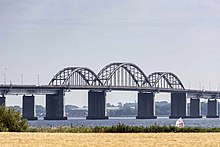Storstrøm Bridge
| Storstrøm Bridge | |
|---|---|
 |
|
| Carries | Road and railway |
| Crosses | Storstrømmen |
| Locale | Denmark |
| Characteristics | |
| Total length | 3,199 metres |
| Width | 9 m |
| Longest span | 136 metres |
| History | |
| Constructed by | Dorman Long |
| Construction end | 1937 |
| Opened | September 1937 |
Storstrøm Bridge (Danish, Storstrømsbroen) is a road and railway arch bridge that crosses Storstrømmen between the islands of Falster and Masnedø in Denmark.
Together with Masnedsund Bridge it connects Falster and Zealand (Sjælland). It was the main road connection between the islands until the Farø Bridges were opened in 1985. It is still part of the railway connection between the islands of Lolland, Falster, and Zealand. It is on the rail line between Copenhagen and Hamburg, Germany.
The Storstrøm Bridge is 3,199 metres long and 9 metres wide. The longest span is 136 metres, and the maximum clearance to the sea is 26 metres. The road is 5½ metres wide. Storstrøm Bridge was opened by King Christian X on 26 September 1937.
The bridge was commissioned by the Danish state railways (De Danske Statsbaner) and designed by them with assistance from Christiani and Nielsen A/S of Copenhagen. Construction was by Dorman Long, with Christiani and Nielsen acting as sub-contractors responsible for foundations and reinforced concrete sections. The contract for the work was signed on 13 May 1933. Bridge designer Anker Engelund and chief civil engineer Guy Anson Maunsell.
The bridge has 49 piers of different heights, extending to a maximum water depth of 13,8 metres. Each pier rests upon concrete foundations cast on the excavated bed of the sea, inside a cofferdam. Some piers could be excavated and cast with the cofferdam empty of water, where the soil was sufficiently waterproof, but others had to be excavated and cast underwater. Steel sheet piles were driven into the bed around the cofferdam. The foundations were continued upwards to a level 3 metres below the water surface.
...
Wikipedia
